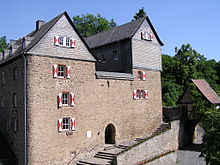Jugendburg

AJugendburg,sometimes referred to in English as ayouth castle,is a mediaeval castle in German-speaking countries that was converted during the 20th century into a public community centre or educational facility for young people. The sponsors of the original youth castles came mainly from theWandervogelandPfadfindermovement, or were at least linked to theyouth movement.
Terminology
[edit]The termJugendburgoriginally referred to the use ofcastles(Burgen) by young people (Jugend).
The difference betweenJugendburgenin this historical sense andJugendburgenin the sense of castles that were used asyouth hostels,for example run by theGerman Youth Hostel Association,is disputed. For example, youth hostels had already emerged in the early 20th century in the wake of the youth movement (Jugendbewegung) as accommodation for young men, youth groups and school classes. And as early as 1912 the first German youth hostel was established byRichard SchirrmannatAltena Castle(it was rebuilt from 1906 to 1915) above the town ofAltena.During theNazi erayouth castles were used by theHitler Youthand theLeague of German Girls,and the term was increasingly associated withNazi ideology.From 1935 to 1943 there was also a schoolchildren's magazine with the titleDeutsche Jugendburg( "German Youth Castle" ), which was published by theNational Socialist Teachers League.
Jugendburgenin the youth movement
[edit]
In connexion withJugendburgenone frequently comes across the names Gustav Wyneken,Robert OelbermannandKarl Oelbermann.
In 1910, the progressive educationalist,Gustav Wyneken,was the chairman of theBund für freie Schulgemeindenand publisher of its magazine. He also tried to found a new school or "Jugendburg" to serve his progressive educational project based on the concept of upbringing as the "Formation of People in the Sense of a Worldview" (Formung des Menschen im Sinne einer Weltanschauung). For Wyneken it was about a redefinition of the relationships between teacher and pupil. This was to be based on "comradeship" (Kameradschaft) and "leadership" (Führertum).
Using his pedagogical approach, Wyneken influenced the emerging youth movement as an adult from 1912 onwards. Wyneken created the concept of "youth culture"in opposition to the perceived subservience ofWilhelmine Germanyas well as against school and family. In 1913, he worked to organise the First Free German Youth Day at theHoher Meissner.Here, too, tensions arose, since Wyneken was a leader figure, a concept rejected by many groups at the youth day. TheFreideutsche Jugendnetwork which emerged that day around theMeissner Declarationhad an anti-rationalist view point at odds with Wyneken's approach.[1]
Fascinated by Wyneken's ideas, the brothers, Robert and Karl Oelbermann, dreamt of theJugendburgconcept after theFirst World War.Robert Oelbermann is considered to be the founder of the "Nerother Wandervogel - Federation for the Establishment of the Rhenish Youth Castle" (Nerother Wandervogel - Bund zur Errichtung der Rheinischen Jugendburg). By "Rhenish Jugendburg", he meantWaldeck Castlein theHunsrückmountains. The Nerother Wandervogel was founded on 27 March 1921 atDrachenfels Castleat Busenberg in theWasgauregion of southwest Germany.
TheJugendburgenwere mostly used to create an independent place of encounter whilst also preserving valuable historical monuments and giving them a new and meaningful use.
Nowadays, the aims of aJugendburgare unchanged; it is about developing young people away from the perceived restrictions and conventions of society.
As the numbers ofscoutsand youth leagues continued to rise, the castles became international meeting places at which camps could be held.
Jugendburgenin Germany
[edit]
- Balduinstein CastleinBalduinstein(Rhineland-Palatinate), 1974
- Camburg CastlenearCamburg(Thuringia), 1935
- EichenkreuzburgnearBissendorf(Lower Saxony), 1928
- Schloss EbersbergnearStuttgart(Baden-Württemberg), 1966
- Feuerstein CastlenearEbermannstadt(Bavaria), 1946
- Gemen CastlenearBorken(North Rhine-Westphalia), 1946
- Hessenstein CastlenearVöhl-Ederbringhausen(North Hesse), 1922
- Hoheneck CastlenearIpsheim(Bavaria), 1984
- Hohenkrähen CastlenearSingen (Hohentwiel)(Baden-Württemberg), 1956
- Hohensolms CastlenearGießen(Hesse), 1924
- Hohnstein CastleinHohnstein (Saxon Switzerland)(Saxony), 1925
- Ludwigstein CastlenearWitzenhausen(Hesse), 1920
- Schloss MansfeldnearMansfeld(Saxony-Anhalt), 1947
- Monschau CastlenearMonschau,1919
- NeuerburginNeuerburg(Rhineland-Palatinate), 1930
- Rieneck CastlenearRieneck(Bavaria), 1959
- Schloss RotenbergnearRauenberg(Baden-Württemberg), 1950
- Rothenfels CastlenearRothenfels(Bavaria), 1919
- SchönburgnearOberwesel(Rhineland-Palatinate), 1951
- Schwaneck CastlenearPullach im Isartal(Bavaria), 1956
- Stahleck CastleinBacharachon theRhine(Rhineland-Palatinate), 1925
- Waldeck CastlenearDorweiler(Rhineland-Palatinate), 1922 (1910)
- Wernfels CastlenearSpalt(Bavaria), 1925
Jugendburgenin Austria
[edit]- Finstergrün CastlenearRamingstein(Salzburg), 1946
- Jugendburg StreitwiesennearWeiten(Lower Austria), 1972
- Wildegg CastlenearSittendorf(Lower Austria), 1947
Jugendburgenin Switzerland
[edit]- Rotberg CastlenearMetzerlen-Mariastein(Solothurn), 1935
References
[edit]- ^Reichenbach, Marie (1978). "Student years: Introductory Note to Part 1".Selected writings, 1909-1953.I.
